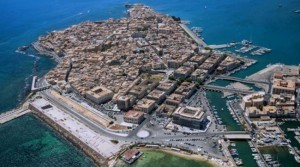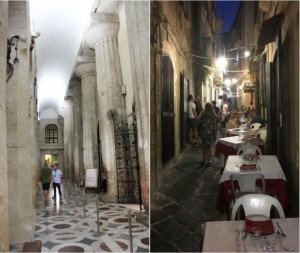More than any other Sicilian city, Syracuse reflects the ancient Hellenic history of the Mediterranean’s largest island. Located on the east coast, Syracuse developed from a Greek colony founded by Corinthians in the 7th century BCE. In the two centuries that followed, the city-state enjoyed a period of expansion and prosperity under the tyrant Dionysius the Elder, who made Syracuse the most powerful of the western Greek colonies. Syracuse, like Sparta and its Peloponnesian allies, was a Dorian city and during the Peloponnesian War (431–404 BCE) it survived a two-year siege by Athenian forces.
The Corinthians established themselves first on the island of Ortygia (the name originates from the Ancient Greek ortyx (όρτυξ) which means ‘quail’) that lies south of the mainland city. Chosen for its natural harbour and spring water, today the remains of 5th and 6th century BCE temples dedicated to Zeus, Apollo, and Athena draw thousands of visitors.
My journey to Syracuse took place in mid-September. The heat of the Mediterranean summer still warmed the ancient stones of the archaeological sites that bear witness to its history. Like most, I headed first for the centre of Ortygia, also known at the Città Vecchia (Old City), and its showpiece square – the Piazza del Duomo. The piazza – a flamboyant example of baroque architecture from the 17th and 18th centuries – sits on what was once an ancient acropolis, and the Duomo (the Cathedral of Syracuse) was built on the site of the Greek temple of Athena. The temple’s Doric columns were integrated into the cathedral’s construction in the 7th century AD. The cathedral’s medieval builders carved archways into the cella (the temple’s sacred central chamber) to transform it into a nave, and between 19 giant columns from the temple’s peristyle, they made the outer walls.
Ortygia is sublime to explore – a labyrinth of laneways soaked in the history of almost 3,000 years. Full of cafes – and some of Sicily’s best traditional restaurants – for any traveller here delicious sustenance is never more than a few footsteps away. Perhaps the best view of the island (now connected to the mainland by three bridges) is from the sea; between March and October 50-minute boat tours circumnavigate Ortygia offering great views of the historic centre.
MAGNA GRAECIA
Magna Graecia (Megali Hellas) was the name given by the Romans to the coastal areas of southern Italy and Sicily colonised by ancient Greek city-states from the 8th to 5th century BCE. As Magna Graecia’s most important metropolis, Syracuse had one of the largest ancient Greek theatres in Europe, and it’s still here. Built in the 5th century BCE with a diameter of some 140 metres, today the theatre is a UNESCO World Heritage Site. You might think the entrance fee of €20 is steep, but its worth it to explore this archaeological treasure.
Four hundred years before Christ, here was the setting where the works of Aeschylus and other Greek writers of the time were performed. It is believed Aeschylus actually saw one of his plays enacted here. That ancient tradition lives on, with annual performances of Classical Greek drama in May and June. The theatre is just one element of this large and fascinating site. Just to the east is Latomia del Paradiso – a vast limestone quarry from where stone for the ancient city of Syracuse was extracted. Full of catacombs, and today filled with citrus and magnolia trees, this is where 7,000 survivors of the war between Syracuse and Athens in 413 BCE were imprisoned. For any philhellene investigating ancient Greek history, Syracuse is a fascinating window into the story of Hellenism in the Mediterranean.
AROUND SYRACUSE
Southeast Sicily is a land of rocky gorges and home to some of the island’s most beautiful towns.
Thirty kilometres due east of Syracuse, the archaeological park of Akrai, near Palazzolo Acreide, contains the ruins of Syracuse’s first inland colony, created to defend the overland trading route to other Greek settlements.
Head south on the E35 highway and you will find gems of beaches at Fontane Bianche and San Lorenzo. Go further to Marzamemi to find one of Sicily’s prettiest seaside villages. To the east of Avola is an area of Unesco-listed hilltop towns famous for their baroque architecture, including Noto, 40 kilometres south of Syracuse.
Half of Italy’s wine production comes from Sicily and the southeast boasts some fine winemakers.
(Ortygia is made up of a labyrinth of alleyways hiding delightful cafes and shops, and restaurants offering typical Sicilian cuisine. Right: Syracuse Cathedral was once the Greek Temple of Athena, built in the 5th century BCE. The temple’s columns were incorporated into the walls of the cathedral in the 7th century AD)
Source: neoskosmos.com
Ask me anything
Explore related questions







